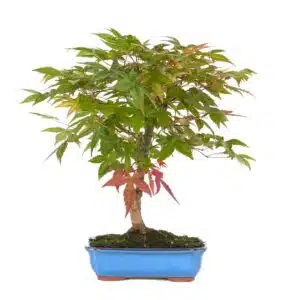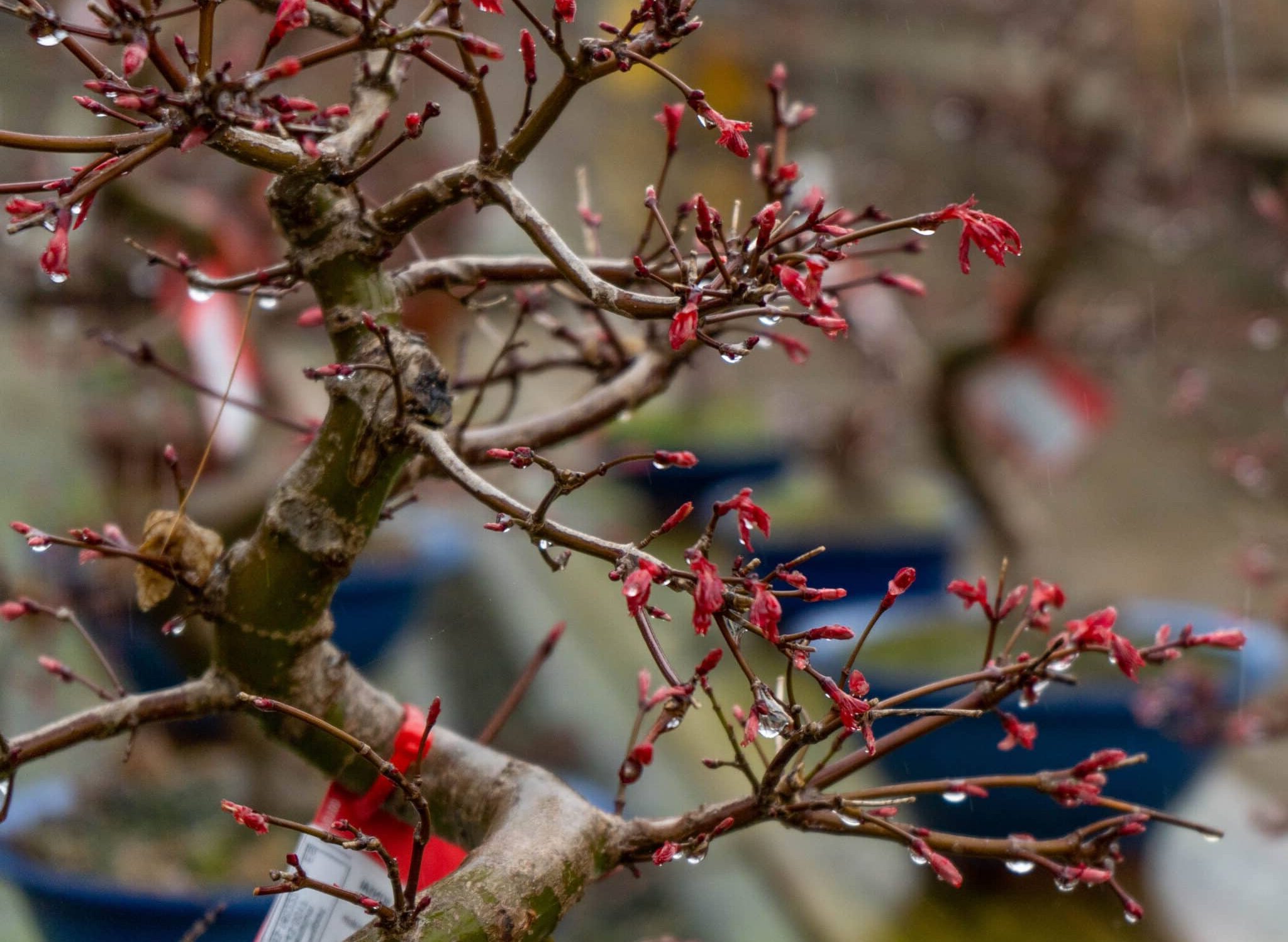All you need to know about deciduous bonsai

Deciduous trees are those that lose their leaves at specific times of the year. In this blog, we will talk about deciduous bonsai that drop their leaves with the arrival of the coldest time of the year.
Deciduous bonsai are a fascinating and beautiful choice for bonsai lovers. These little wonders not only add beauty to any space, but also offer a dynamic look at the seasons throughout the year. In this article, we will explore the characteristics of deciduous bonsai, which are the most popular species, care recommendations, and other interesting concepts related to these small trees.
Features of deciduous bonsai
Deciduous bonsai are characterised by their seasonal life cycle. Between late summer and early autumn, the tree collects all the nutrients and water accumulated in its leaves and concentrates it in its branches and trunk, creating a supply for the spring sprouting. It is for this reason that you will see its leaves begin to dehydrate, changing colour and finally falling off, leaving the branches completely bare in winter.

In addition, pruning will encourage healthy and balanced growth, giving you the opportunity to remove structurally unwanted branches. With the arrival of spring weather, the sap flows intensively through the branches again, giving way to new sprouting. This is the perfect time to refine the branching of the bonsai, as the flexibility of the branches facilitates the wiring process without causing damage.
Deciduous bonsai tree care
Taking care of a deciduous bonsai requires attention to some details in order to ensure a proper growth, good health and longevity. Here are the essentials to consider:
Proper irrigation
It is essential to maintain a balanced watering. In winter, the water requirements decrease, so the frequency of watering should also be reduced.
Solar exposure
Deciduous bonsai generally need direct sunlight to grow. However, in summer, when the sun is at its highest, it is recommended to place them in semi-shade to delay the dehydration of the leaves.
Pruning and pinching
Regular pruning is vital to keep the shape and health of the bonsai, and to modify the structure of the tree if desired. Pinching helps to maintain the size and shape we want, while improving the compactness of the canopy.
Wiring
It helps to shape the bonsai’s branching by modifying the direction of growth of the branches.
Repotting
The vast majority of deciduous bonsai are repotted in early spring, just before the new shoots start to open. There are many different combinations of soils, but for Mistral Bonsai the ideal mix for a good growth would be to combine the ease of nutrient absorption, optimum moisture retention and good drainage offered by the Special Substrate Pack for deciduous bonsai.
Fertilising
From spring to summer, deciduous bonsai need active fertilisation as they are in full growth, and it will help them to keep vigorous. In autumn, we will reduce the frequency of fertilisation, stopping it in winter months, once they have lost their leaves. Use a balanced fertiliser and make sure you do not overfeed your bonsai.
Most popular deciduous bonsai species
There are many species of deciduous bonsai with their own characteristics and their own charm. Here is a list of the 10 most popular species. You can find them all in our online shop:
 |
Acer palmatum (Japanese maple)Known for the beautiful and bright colouring of its foliage, it changes according to the varieties and seasons with reddish, orange or golden, colours. The maple, in all its varieties, is one of the most popular bonsai. Clipping should be done before the shoot becomes longer. |
|
|
Ginkgo bilobaIt is considered a sacred tree and is also the oldest plant, as it already existed in prehistoric times and in the time of the dinosaurs. Its leaves are fan-shaped, and it is highly appreciated for its golden autumn colouring. Learn more about Ginkgo biloba on the blog Ginkgo biloba: Maidenhair tree bonsai. |
|
|
Malus (apple tree)Highly appreciated for its spring flowering and the colouring of its small fruits in autumn, which remain on the bonsai even after the leaves have fallen. There are different varieties with fruit colouring ranging from yellow, orange,-red… Find out how to increase the foliage density of your Malus on this link. |
 |
Ficus carica (fig tree)Widely known in the Mediterranean area, it is a tree appreciated for its attractive edible fruits. In nature, it usually grows wild in places that are difficult to access, such as cliffs. |
 |
Punica granatum (pomegranate tree)Characterised by its thorny branches, its abundant reddish blossom and its beautiful fruits, especially in the nana variety. |
 |
PrunusIn their natural environment, they are trees that can grow up to 3 to 5 metres high. Their blossom is white and pink. And we can find species such as the almond tree (Prunus dulcis), the St. Lucia cherry tree (Prunus mahaleb) or the Shanghai cherry tree (Prunus tomentosa). Find out about the different varieties here. |
 |
Morus (mulberry)Its reddish fruits are edible when they darken when ripe. It is characterised by the change in colour of its green leaves to an intense yellow in autumn. |
 |
Quercus suber (cork oak)Is a highly appreciated bonsai because of the rough texture of its trunk and branching, giving a beautiful old bonsai appearance. Natural cork is extracted from these trees. |
|
|
MetasequoiaWith its reddish bark and pointed leaves, this bonsai can adapt to almost any environment, including the coldest and wettest climates. It is known as Dawn redwood. |
|
…………………… |
Pseudolarix (golden larch)Appreciated for the fine texture of its leaves and its clear, smooth bark. It is also notable for its elegant appearance and the soft greenish colouring of its canopy. |
For these last two, don’t miss this blog on their differences and similarities: Differences between the Metasequoia and Pseudolarix bonsai.
What to do with burnt leaves on my bonsai?

The best option is to let nature take its course and let the tree itself shed the leaves. Once leaf fall has ended, the tree will go into dormancy due to the lower winter temperatures, awakening in the spring, to sprout again in full vigour.
Enjoy the change of seasons from your terrace
Deciduous bonsai are a wonderful choice for any bonsai lover, providing a unique seasonal display and a deep connection with nature. With proper care, patience and dedication, these small trees will become a source of beauty and satisfaction for many years.
You may also be interested in:
About the Author
Mistral Bonsai
In Mistral Bonsai we are a communication team, technicians and masters committed from the first day to disseminating the wonderful art of bonsai. A world that offers many things to share. We believe that a bonsai is a tree with a soul, unique and unrepeatable. Another of our most essential pillars is, how could it be otherwise, our close commitment to the preservation of the environment and nature.
Categories
Bonsai cultivation and care (60)
Bonsai gift (2)
Bonsai pests and diseases (7)
Bonsai repotting (3)
Bonsai species (1)
bonsai substrates (2)
Bonsai summer (1)
bonsai tools (1)
Bonsai work (13)
Ceramic pots (3)
Chinese culture (1)
Chinese culture (2)
Coniferous bonsai (2)
Conifers (1)





